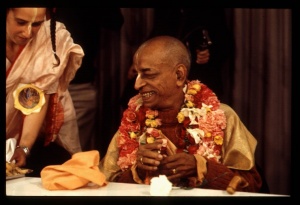SB 9.20.16: Difference between revisions
m (1 revision(s)) |
No edit summary |
||
| Line 1: | Line 1: | ||
{{info | {{info | ||
|speaker= | |speaker=Śukadeva Gosvāmī | ||
|listener=King | |listener=King Parīkṣit | ||
}} | }} | ||
[[Category:Srimad-Bhagavatam - Canto 09 Chapter 20]] | |||
[[Category:Bhagavatam Verses Spoken by Sukadeva Gosvami - Vanisource|092016]] | |||
<div style="float:left">'''[[Srimad-Bhagavatam]] - [[SB 9|Ninth Canto]] - [[SB 9|Ninth Canto]] - [[SB 9.20: The Dynasty of Puru|Chapter 20: The Dynasty of Pūru]]'''</div> | |||
<div style="float:right">[[File:Go-previous.png|link=SB 9.20.15]] '''[[SB 9.20.15]] - [[SB 9.20.17]]''' [[File:Go-next.png|link=SB 9.20.17]]</div> | |||
{{RandomImage}} | |||
==== TEXT 16 ==== | ==== TEXT 16 ==== | ||
<div | <div class="verse"> | ||
om ity ukte yathā-dharmam | :om ity ukte yathā-dharmam | ||
upayeme śakuntalām | :upayeme śakuntalām | ||
gāndharva-vidhinā rājā | :gāndharva-vidhinā rājā | ||
deśa-kāla-vidhānavit | :deśa-kāla-vidhānavit | ||
</div> | </div> | ||
| Line 17: | Line 22: | ||
==== SYNONYMS ==== | ==== SYNONYMS ==== | ||
<div | <div class="synonyms"> | ||
om iti | ''om iti ukte''—by reciting the Vedic ''praṇava'', invoking the Supreme Personality of Godhead to witness the marriage; ''yathā-dharmam''—exactly according to the principles of religion (because Nārāyaṇa becomes the witness in an ordinary religious marriage also); ''upayeme''—he married; ''śakuntalām''—the girl Śakuntalā; ''gāndharva-vidhinā''—by the regulative principle of the Gandharvas, without deviation from religious principles; ''rājā''—Mahārāja Duṣmanta; ''deśa-kāla-vidhāna-vit''—completely aware of duties according to time, position and objective. | ||
</div> | </div> | ||
| Line 24: | Line 29: | ||
==== TRANSLATION ==== | ==== TRANSLATION ==== | ||
<div | <div class="translation"> | ||
When Śakuntalā responded to Mahārāja Duṣmanta's proposal with silence, the agreement was complete. Then the King, who knew the laws of marriage, immediately married her by chanting the Vedic praṇava [oṁkāra], in accordance with the marriage ceremony as performed among the Gandharvas. | When Śakuntalā responded to Mahārāja Duṣmanta's proposal with silence, the agreement was complete. Then the King, who knew the laws of marriage, immediately married her by chanting the Vedic praṇava [oṁkāra], in accordance with the marriage ceremony as performed among the Gandharvas. | ||
</div> | </div> | ||
| Line 31: | Line 36: | ||
==== PURPORT ==== | ==== PURPORT ==== | ||
<div | <div class="purport"> | ||
The oṁkāra, praṇava, is the Supreme Personality of Godhead represented by letters. Bhagavad-gītā says that the letters a-u-m, combined together as oṁ, represent the Supreme Lord. Religious principles are meant to invoke the blessings and mercy of the Supreme Personality of Godhead, Kṛṣṇa, who says in Bhagavad-gītā that He is personally present in sexual desires that are not contrary to religious principles. The word vidhinā means, "according to religious principles." The association of men and women according to religious principles is allowed in the Vedic culture. In our Kṛṣṇa consciousness movement we allow marriage on the basis of religious principles, but the sexual combination of men and women as friends is irreligious and is not allowed. | The ''oṁkāra'', ''praṇava'', is the Supreme Personality of Godhead represented by letters. [[Bhagavad-gita As It Is (1972)|''Bhagavad-gītā'']] says that the letters ''a-u-m'', combined together as ''oṁ'', represent the Supreme Lord. Religious principles are meant to invoke the blessings and mercy of the Supreme Personality of Godhead, Kṛṣṇa, who says in [[Bhagavad-gita As It Is (1972)|''Bhagavad-gītā'']] that He is personally present in sexual desires that are not contrary to religious principles. The word ''vidhinā'' means, "according to religious principles." The association of men and women according to religious principles is allowed in the Vedic culture. In our Kṛṣṇa consciousness movement we allow marriage on the basis of religious principles, but the sexual combination of men and women as friends is irreligious and is not allowed. | ||
</div> | </div> | ||
__NOTOC__ | |||
<div style="float:right; clear:both;">[[File:Go-previous.png|link=SB 9.20.15]] '''[[SB 9.20.15]] - [[SB 9.20.17]]''' [[File:Go-next.png|link=SB 9.20.17]]</div> | |||
__NOTOC__ | |||
__NOEDITSECTION__ | |||
Revision as of 05:20, 17 May 2021

A.C. Bhaktivedanta Swami Prabhupada
TEXT 16
- om ity ukte yathā-dharmam
- upayeme śakuntalām
- gāndharva-vidhinā rājā
- deśa-kāla-vidhānavit
SYNONYMS
om iti ukte—by reciting the Vedic praṇava, invoking the Supreme Personality of Godhead to witness the marriage; yathā-dharmam—exactly according to the principles of religion (because Nārāyaṇa becomes the witness in an ordinary religious marriage also); upayeme—he married; śakuntalām—the girl Śakuntalā; gāndharva-vidhinā—by the regulative principle of the Gandharvas, without deviation from religious principles; rājā—Mahārāja Duṣmanta; deśa-kāla-vidhāna-vit—completely aware of duties according to time, position and objective.
TRANSLATION
When Śakuntalā responded to Mahārāja Duṣmanta's proposal with silence, the agreement was complete. Then the King, who knew the laws of marriage, immediately married her by chanting the Vedic praṇava [oṁkāra], in accordance with the marriage ceremony as performed among the Gandharvas.
PURPORT
The oṁkāra, praṇava, is the Supreme Personality of Godhead represented by letters. Bhagavad-gītā says that the letters a-u-m, combined together as oṁ, represent the Supreme Lord. Religious principles are meant to invoke the blessings and mercy of the Supreme Personality of Godhead, Kṛṣṇa, who says in Bhagavad-gītā that He is personally present in sexual desires that are not contrary to religious principles. The word vidhinā means, "according to religious principles." The association of men and women according to religious principles is allowed in the Vedic culture. In our Kṛṣṇa consciousness movement we allow marriage on the basis of religious principles, but the sexual combination of men and women as friends is irreligious and is not allowed.